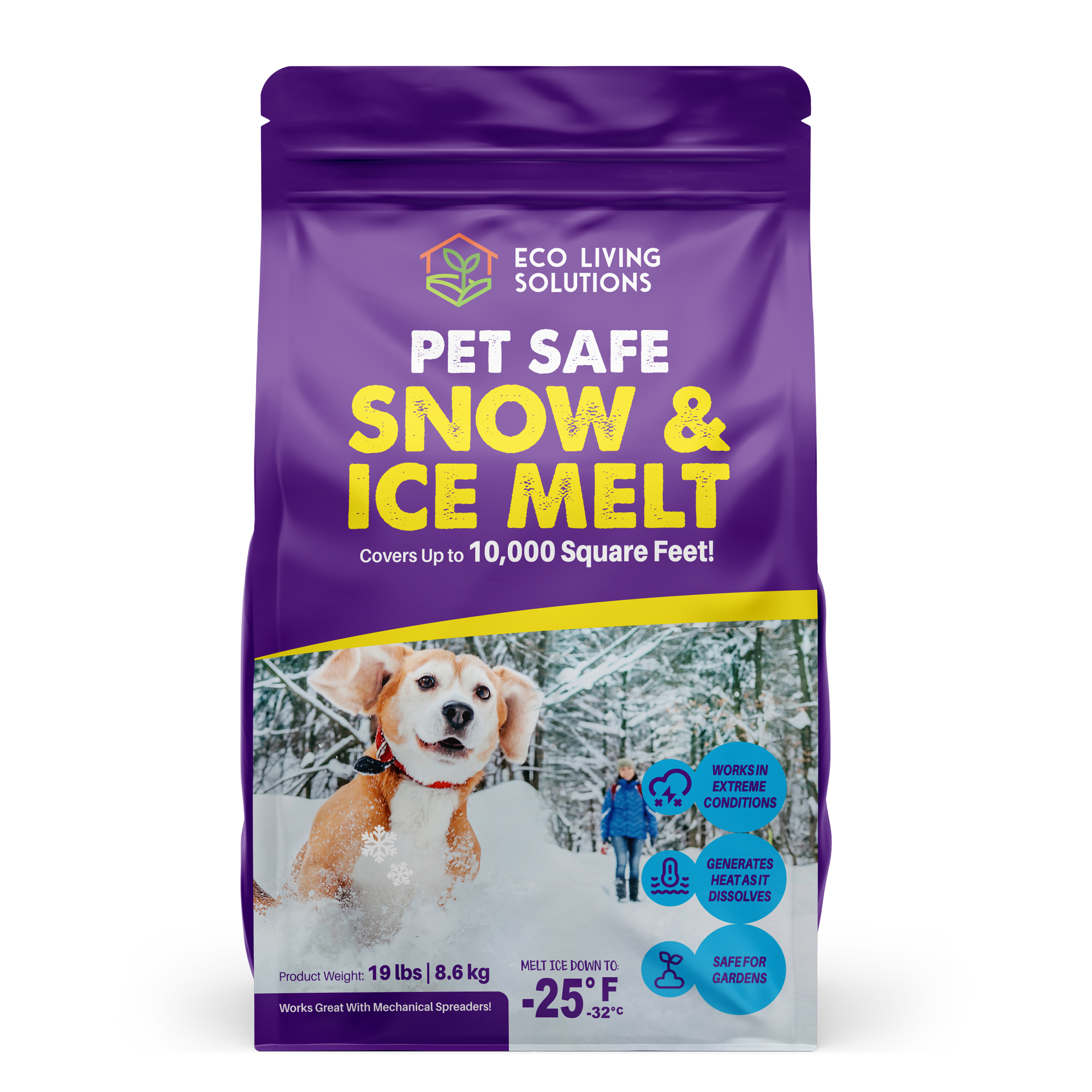There are many types of ice melt, and it can be difficult to decide which one to use. The added challenge is that winter weather is often unpredictable, and when you need snow and ice melt fast, same day delivery or in store availability may be limited. Nearby stores may also be sold out due to winter weather. With free next day delivery, fast shipping, and in stock availability - online options like Amazon, Walmart, Home Depot, and Lowes offer access to great promotions and selection.
What are my Options?
Some of the options are sodium acetate, calcium chloride, liquid brine, or even beet juice. Calcium chloride is the best option for melting ice, but sodium acetate is also a great alternative, however, it can be a little more difficult to work with.
Free Next Day Delivery or in Store Checkout?
Recent searches indicate that shoppers are 29% more likely to purchase online if same day delivery or free next day delivery is available. If stores don't have reliable inventory or stock, online shopping provides convenience and unlimited availability, often coupled with free next day shipping.
Before Going Further - Checkout Our Selection of Pet Safe Ice Melt Here


Sodium Acetate
Sodium acetate is a biodegradable deicer that is not toxic to fish or animals. It also has a long residual effect, which makes it ideal for ice melting in cold climates. It is approved by the FAA for use on commercial airport runways. Sodium acetate is available in pellet form and contains 97% of the active ingredients.

Another advantage of sodium acetate is that it has a lower environmental impact. This chemical has a lower melting point than sodium chloride, which is harmful to plants and water. Sodium acetate is also safer for hard surfaces because it is non-corrosive. It can work effectively even at temperatures below -25 degrees Fahrenheit.
Two of the biggest disavantages of sodium acetate is it's pricing and sodium content. Just like sodium chloride, sodium aceate contains sodium ions, which can be toxic for your pets, lawn, and trees if applied in excess. Look for a sodium free product if you are looking for a pet safe ice melt. And while prices will vary from store to store, sodium acetate snow and ice melt prices are typically 42% higher than conventional sodium chloride products found in store.
Calcium Chloride Pellets or Magnesium Chloride
Calcium chloride is another effective ice melt. This chemical reduces the freezing point of water and generates heat to melt ice faster. Calcium chloride is also the least expensive of the two and relatively environment-friendly. It works best in colder climates, but is moderately corrosive. Sodium acetate, on the other hand, works well in cold climates, but is more expensive than competing products.
Calcium chloride is a common ingredient in ice melt products. It is also cheaper than sodium acetate. Its main function is to attract moisture and form brine, lowering the freezing point of water.
Magnesium chloride is also an environmentally safe ice melt alternative. They are also safer for pets and vegetation. They also melt ice below 12 degrees and are less harmful to the environment. They can be used around airports and buildings because they are less corrosive.
If you're looking for an environmentally friendly ice melt that's safe for you and your pets, you should consider calcium chloride. This product melts ice up to -25 degrees Fahrenheit and also a pet-friendly alternative to rock salt. However, it should be used sparingly, as a little goes a long way. Using calcium chloride in moderation is crucial to ensure your property's safety.
Calcium chloride is a chemical compound that can be made into an ice-melting solution by combining with water. The resulting solution is highly soluble in water and attracts moisture from its surroundings. It then creates a brine that melts the surrounding ice. The process of melting ice produces more water than it consumes.
Calcium chloride for ice melt is safe for use on ice and snow, but excessive usage can cause dryness. However, calcium chloride for ice melt is not harmful to concrete and asphalt. When used appropriately, calcium chloride for ice melt is safe and effective at -25 degrees Fahrenheit.
Among the many uses for calcium chloride for ice melt, the most common is in deicing. The compound absorbs water from the atmosphere to form a brine, which then melts more ice. It also removes harmful dust from the air. Because of its unique properties, calcium chloride is much more efficient than rock salt and other alternatives.
Liquid Brine
Ice melt liquid brine is an inexpensive solution for anti-icing. Like rock salt, it works by breaking down the ice and preventing it from bonding to the surface. But unlike salt, which must undergo a chemical reaction with water before it can be used, liquid ice melt can be applied before the snow starts to fall. It works more slowly than salt, but still keeps the surface free of ice.

Liquid brine works at lower temperatures, so it is more versatile than rock salt and is therefore more effective in cold climates like Chicago. It also reduces contaminants in the water, protecting freshwater plant life. However, you should remember that brine is not as effective on cars as rock salt. Because the liquid brine is already pre-dissolved, it can be applied virtually at any temperature, increasing its effectiveness.
Liquid ice melt is an environmentally-friendly option, but it is not a good choice if you're concerned about spilling the ice melting solution on landscaping or natural areas. In fact, liquid ice melt may not even work as well in these cases. You should always check the label to make sure the product you're using is safe for the environment.
Another liquid option is CryoMelt C. This bio-polymer is green in color and free from magnesium and calcium chloride. It can be mixed with salt brine to make a road-ready blend. This solution is ideal for anti-icing and prewetting operations. You can also use 30% Magnesium Chloride Solution as an alternative to liquid calcium chloride. It's perfect for pre-wetting rock salt, and can be blended with salt to form a "Supermix" style mixture.
When it comes to snow removal, it's important to have the right supplies on hand. If you're not prepared, your business could get a hit from the end-of-season snowstorm. Bulk-outing your supplies can save you money and help you stand out from the "chuck in a truck" guys. Taking stock of your inventory before buying a brine maker will ensure you're prepared.
Beet Juice
If you live in an area where ice and snow are a problem, you might be looking for a way to deal with it. A new type of snow melt is making its way to the market, and it uses beet juice to reduce the freezing point of ice and snow. This type of ice melt is safe to use on cars and other surfaces, and it does not cause any pollution. Its natural anti-corrosion properties make it a safe alternative to conventional salt. Additionally, it can be used as a pretreatment to prevent ice buildup and reduce the amount of deicing material required.
While salt melts are known to have some negative environmental consequences, beet juice melt has fewer. Because the solution contains sugar from beets, it lowers the freezing point of ice, which makes it less likely to form. This means fewer ice melt disasters!
Another advantage of this type of ice melt is that it is pet-friendly, meaning you won't have to worry about damaging your property. Using beet juice, however, does require that you have a sprayer. You can use a hand-held sprayer, but an electric one is simpler to use.
Beet juice salt is an alternative to rock salt and has become more widespread in the past decade. While some municipalities were slow to adopt beets on their streets, it has been widely used throughout the country.
While beet juice salt is a green alternative to traditional salt that does not harm the environment, there are several major disadvantages to using beet juice as an ice melt or a deicer.
-
The working temperature (-2 degrees Fahrenheit) is significantly higher than conventional rock salt or calcium chloride products. This means that some regions of the country, especially those impacted by severe and deep winter weather, will not benefit from the product's effectiveness.
-
The higher working temperature also means that the product is prone to re-freezing and forming ice crystals, especially when overnight temperatures dip into the negative. This re-freezing can cause damage to cracked concrete, damage driveways, and make sidewalks and block pavers slippery.
-
Price - this is the final and the biggest limitation of beet juice as an ice melt product. Because the product is derived as a by-product of sugar beet production, transportation and usage make the solution prohibitively expensive for most homeowners. The other drawback is that the product is often provided in a liquid format, requiring complicated sprayers to apply. Compared to traditional granulated or pelletized ice melts, which can be spread by hand without the requirement for further equipment.
While there are lots of options for choosing an ice melt product this winter - the biggest piece of advice we can offer, is to stay prepared and plan ahead of time to clear snow and ice around your home or business. This means ordering equipment in advance and applying any pre-treatment ahead of any winter storm events. Choosing to wait until the last minute, or when the storm has arrived, can mean shortages of vital tools and equipment - and this can mean the difference between staying safe and risking your life during unpredictable winter weather.
Cheers!
